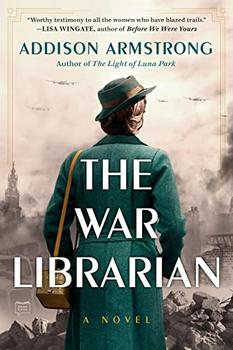Summary | Excerpt | Reading Guide | Reviews | Beyond the book | Read-Alikes | Genres & Themes | Author Bio

The Women of Chateau Lafayette, Stephanie Dray's latest work of historical fiction, revolves around three courageous individuals who navigate the dangers of warfare during different time periods: Adrienne Lafayette (1759-1807), a politically astute woman who helped her husband usher in the French Revolution only to narrowly survive its aftermath; Beatrice Ashley Chanler (c.1880-1946), a colorful New York actress who braved ocean crossings and bombed-out French towns to provide relief to World War I soldiers and support for children orphaned by the war; and Marthe, a fictional World War II heroine representing the unknown people responsible for rescuing Jewish children from the Gestapo. Tying the three women together is the Chateau Lafayette, the ancestral home of the Lafayette family, parts of which served as an orphanage and hospital during and after the two wars.
Dray bounces back and forth between the three women's timelines. Each section is narrated by one of them in the first person. It can be challenging to write a novel, particularly one of this length, where three similar characters retain distinct voices and personalities throughout, but the author allows each to clearly shine through — Adrienne, for example, is idealistic and religious while Beatrice is brash and unflappable. Marthe, Dray's purely fictional construct, is utterly believable and multifaceted.
The first half of the novel is primarily set-up, establishing the main characters' personalities and motivations — they're witnesses to history but haven't yet taken steps to become a part of it. The author accomplishes this superbly, and by the book's midpoint, we feel like each is an intimate friend. In addition, the level of historical detail Dray slips in here and there is marvelous. At one point, for instance, Marthe, a Frenchwoman, thinks that it's hard to consider the British allies "since Churchill bombed our fleet to keep it out of German hands" — an act that resulted in the deaths of 1,297 French mariners. In another chapter, Beatrice notes that the Eiffel Tower was "armed with antiaircraft guns and encircled with barbed wire." I truly enjoyed these tidbits of history — little details of the time periods that I knew nothing about. This first part of the novel is a bit slow-going (particularly when one keeps turning to Wikipedia for more information, as I did) but fascinating nonetheless.
Starting after page 200 or so, the action picks up as each of the heroines faces life-threatening circumstances. Dray's writing remains vivid from start to finish, but in this latter half there's less reflection and more movement. It's not as intellectually stimulating as the first half, perhaps, but it's at least as entertaining.
The author's note is enlightening, but I felt it did the book a bit of a disservice. Dray states that her purpose in writing the novel was to highlight how "the torch was passed to new generations who made [Chateau Lafayette] a sanctuary for orphaned children and orphaned ideals that lit the way for humanity through three of history's darkest hours." I never really felt the connection between the women or their ideals, though, and as a result the book was more like three unconnected stories. It seemed to me that this "passing of the torch" didn't really happen, narratively, and knowing that the author's stated goal wasn't achieved left me a bit dissatisfied with the end product as a whole. This feeling was exacerbated by Dray discussing the elements she left out of Adrienne's and Beatrice's stories; I wanted to know more about these women, and wondered if she would have been better off writing separate novels about each and including some of the information she chose to omit. In addition, I found the narrative's use of brief chapters to be disorienting. I'd find myself really getting involved in one plot, only to have to abruptly switch gears to resume one of the other storylines. This added to my opinion that the book could have been at least two and perhaps three separate works.
Those criticisms aside, The Women of Chateau Lafayette is historical fiction at its finest; each of the three stories is excellently crafted and contains a wealth of detail aficionados of the genre will enjoy. Dray's characterizations are top-notch and will likely earn the author both fans and accolades. The book is especially recommended for those who enjoy novels highlighting women's roles in history.
![]() This review was originally published in The BookBrowse Review in April 2021, and has been updated for the
March 2022 edition.
Click here to go to this issue.
This review was originally published in The BookBrowse Review in April 2021, and has been updated for the
March 2022 edition.
Click here to go to this issue.

If you liked The Women of Chateau Lafayette, try these:

by Stephanie Dray
Published 2025
New York Times bestselling author Stephanie Dray returns with a captivating and dramatic new novel about an American heroine Frances Perkins.

by Addison Armstrong
Published 2022
The Paris Library meets The Flight Girls in this captivating historical novel about the sacrifice and courage necessary to live a life of honor, inspired by the first female volunteer librarians during World War I and the first women accepted into the U.S. Naval Academy.
Your guide toexceptional books
BookBrowse seeks out and recommends the best in contemporary fiction and nonfiction—books that not only engage and entertain but also deepen our understanding of ourselves and the world around us.